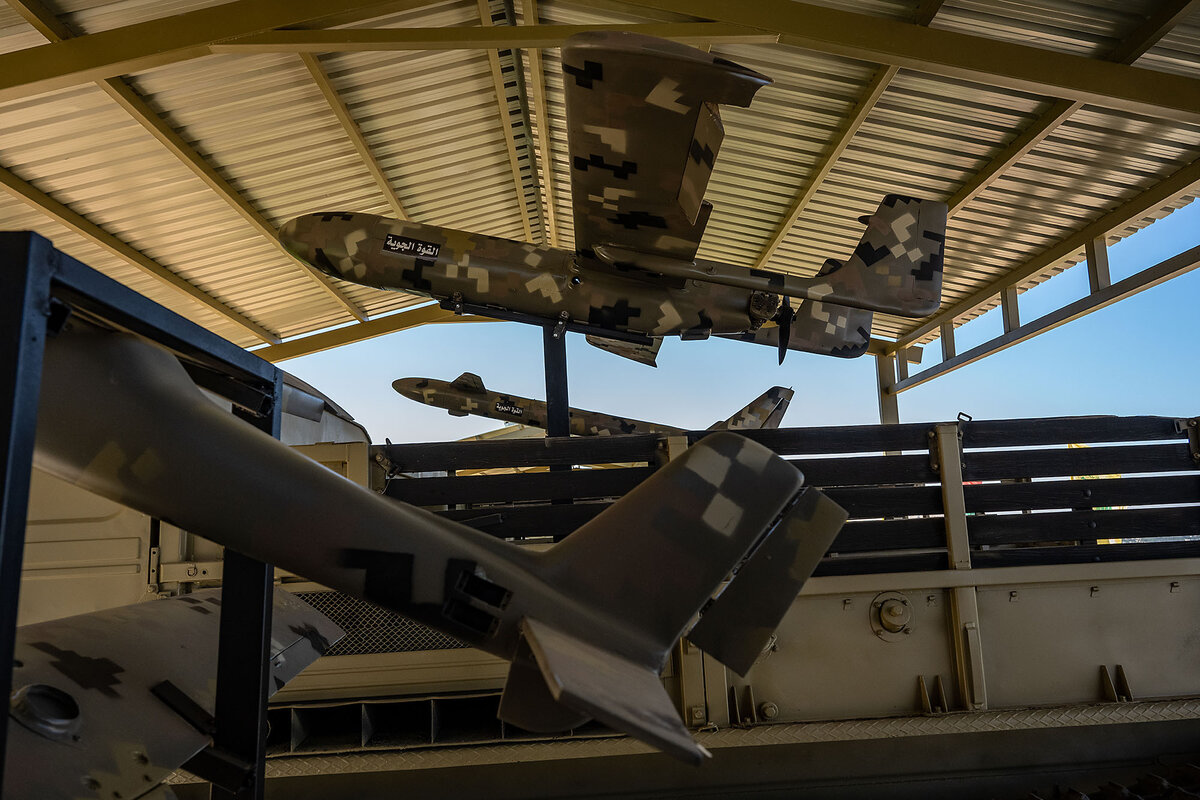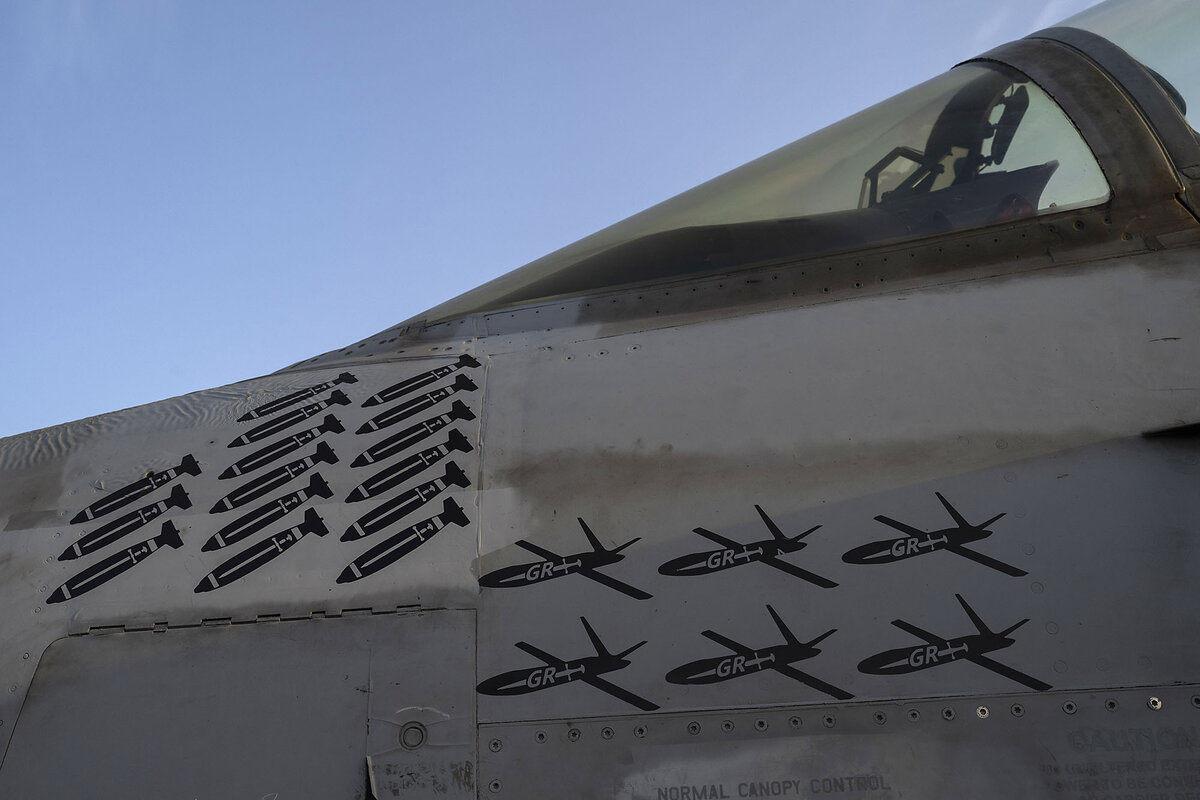Wars of the future will be awash with drones. The Pentagon is trying to keep up.
Loading...
From the battlefields of Ukraine to the seas around the Middle East, U.S. commanders are getting a glimpse into what wars of the future will look like, and they say one thing is clear: The horizon line will be teeming with drones.
Ukrainian soldiers remotely controlling quadcopters are now engaging in midair dogfights, searching for blind spots to knock out the rudders of uncrewed Russian crafts rigged with bombs.
Kyiv earlier this year was forced to sideline U.S. Abrams tanks, because too many were being destroyed by drones, The Associated Press reported in April. (This was after many months of lobbying Washington to finally get 31 of them, worth some $10 million each.)
Why We Wrote This
A story focused onConflicts in Ukraine and the Middle East highlight the growing role of inexpensive drones in battle and are pushing the U.S. Department of Defense to rethink its war-fighting strategy.
At the same time, Department of Defense officials express frustration that the Navy must use pricey missiles to shoot down far more affordable Iranian-made drones launched by Houthi rebels into the Red Sea. For the first time, the rebels earlier this month also used a remote-controlled ocean drone to force the crew of a Greek-owned vessel to abandon ship.
Unmanned vehicles, as they’re known in Pentagon parlance, are quickly becoming the “poor man’s cruise missile” – cheap and plentiful compared with the very fancy hardware they’re destroying, says Behnam Ben Taleblu, senior fellow at the Foundation for Defense of Democracies think tank.
“Quantity now has a quality of its own – and our adversaries understand this,” he says.
When the chief of the French army last week remarked that the dominance of drones is but “a snapshot in time,” some analysts compared it to early 20th-century commanders who dismissed airplanes and tanks “as only accessories to the man and the horse,” as a 1926 Times of London piece put it.
Today’s drone developments are forcing the Pentagon to tear up many of the plans it once had for fighting wars and to get creative in developing new technologies, including directed-energy weapons like lasers.
“There’s really good and necessary experimentation happening,” says Stacie Pettyjohn, director of the defense program at the Center for a New American Security think tank.
At the same time, the Pentagon is asking itself some tough questions about the exquisite weapons on which it has long relied to execute U.S. military strategy – and that can be decades in development.
Whether these questions are tough enough, analysts add, remains to be seen.
U.S. soldiers fighting future wars “are going to be pummeled by the saturation of the drones on the battlefield,” says retired Lt. Gen. David Barno, former commander of U.S. forces in Afghanistan and now professor of practice at the Johns Hopkins University School of Advanced International Studies. “We have nothing like that ourselves – no offensive mass drone capability – and very limited ability to protect against it.”
For the Pentagon, moving quickly to change this is the challenge and, historically, he adds, “the opposite of everything it’s designed to do.”
“Learning from the battlefield”
The proliferation of inexpensive drones on the battlefield is not a brand-new development.
When the United States was helping Iraq fight off Islamic State (ISIS) forces massed in Mosul in 2016, the “year’s most daunting problem was an adaptive enemy who, for a time, enjoyed tactical superiority ... in the form of commercially available drones,” Gen. Raymond Thomas, then head of U.S. Special Operations Command, said in 2017.
Around that time, another U.S. four-star general, David Perkins, complained to an Army conference audience that an ally had shot down a cheap off-the-shelf drone with a $3.4 million Patriot missile.
“Now that worked – they got it,” he said. The problem is, “If I’m the enemy, I’m thinking, ‘Hey I’m just going to get on eBay and buy as many of these $300 quadcopters as I can and expend all the Patriot missiles out there.’”
Recalling that same time period, Undersecretary of the Army Gabe Camarillo last month acknowledged, “It was really challenging to figure out how to actually defeat these small drones that were dropping bombs.”
It was the beginning of a wake-up call for the Pentagon, and one driven home in January, when three U.S. service members, deployed to an outpost in Jordan as part of a campaign against ISIS, were killed in an attack by cheap exploding drones developed by Iran.
The following month, the Army announced that it was canceling a crewed scout helicopter – the Future Attack Reconnaissance Aircraft, once a top priority for the service – in favor of investing more in uncrewed aircraft.
Analysts pointed to this moment as an important shift in thinking. “We are learning from the battlefield,” Gen. Randy George, Army chief of staff, said in announcing the cancellation, “especially in Ukraine.”
Experimenting with new weapons
Today, the Middle East “has become a sandbox of experimentation,” Dr. Pettyjohn says, as money once slated for the multibillion-dollar helicopter is being diverted into developing small attack drones and better counterdrone technologies.
“We’ve been successful in getting some prototypes out, and I think we’re beginning to learn a lot from those,” Undersecretary Camarillo said during a discussion last month.
This includes directed-energy weapons like lasers and microwave blasts, the latter of which are roughly 150,000 times more powerful than their namesake household appliance.
The Army is testing out directed-energy weapons in the field as it combats drones in the Middle East, Gen. Michael “Erik” Kurilla, head of U.S. Central Command, told lawmakers in March.
But as Houthi rebels in Yemen step up drone strikes on ships in the Red Sea, he stressed that he’d like to see similar technology on U.S. vessels as well.
“I would love to have the Navy produce more directed energy that can shoot down a drone, so I don’t have to use an expensive missile,” General Kurilla said. Instead of millions, the price tag for directed energy is, he noted, “a dollar or two a round.”
With these critiques in mind, Pentagon officials in August announced the Replicator Initiative. Conjuring up images of the Starship Enterprise, the program’s goal, they say, will be creating legions of inexpensive, small drones to be used essentially as “attritable autonomous systems,” to be reused at most a few times.
This will not only fill a gap in America’s defenses, they add, but also create an incentive for American startups to challenge China’s current domination of the drone market.
“Now if you’re a cynic – or just a realist – you’re thinking, ‘C’mon, Deputy! This is the Pentagon you’re talking about! You’re too slow!’” Deputy Secretary of Defense Kathleen Hicks said during the initiative’s rollout.
She sympathized with the critique, but this time, she assured her audience, “We are not taking our foot off the gas.”








